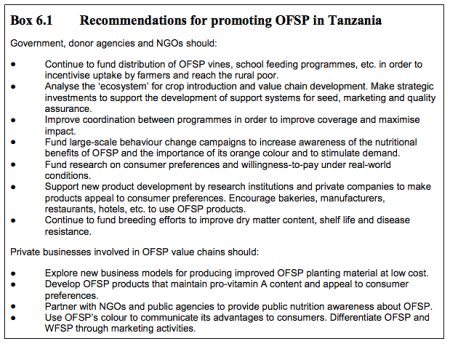Good to see the March edition of Hortinews magazine focusing on the sweetpotato in Africa. 1 I found it a little difficult to navigate the feature online, although you can also just download the whole issue as a pdf, so let me link directly to two stories on orange-fleshed sweetpotatoes (OFSP):
- Shaping up the orange-fleshed sweetpotato: Shamba Shape Up programme aired 8 episodes about the orange-fleshed sweetpotato, focusing on planting, diseases, storage, cuttings, vine health and cooking on Citizen TV.
- Nutritional analysis is critical to the development of OFSP in SSA: CIP advocated for increased nutrition related research at BecA-ILRI to meet the growing demand for quality nutritional analysis.
Now, a lot of effort has gone into developing and disseminating OFSP in parts of Africa, and their potential importance in addressing vitamin A deficiency is not disputed. However, not everything has gone totally smoothly. As an IDS report, coincidentally also just out, points out:
Donor-funded initiatives have played a central role in developing all stages of the OFSP value chain, with a particular focus on breeding new varieties that appeal to the preferences of both producers and consumers. Development projects have also supported the dissemination of planting materials and funded public awareness campaigns. However, information collected for this case study suggests that, so far, interventions have not achieved widespread uptake of OFSP. Only a small minority of farming households in intervention districts grow OFSP. 2 Commercial farmers who supplied OFSP planting materials to project distribution systems have found that, after project funding ended, the local market was not viable, and have ceased production. Meanwhile, awareness of and demand for the crop among consumers have been very limited; one survey conducted in an intervention district found that only 2 per cent of households consumed OFSP. Traders and food processors report that there is little demand, and dealing with the crop is not profitable. This state is perhaps unsurprising given that the introduction of OFSP is still relatively recent, that project efforts have been relatively scattered and uncoordinated, and that there has been little focus on commercially viable value chains. Yet the challenges encountered in Tanzania provide important lessons for other agriculture-nutrition initiatives.
But no need to panic, all is not lost. It’s still relatively early days yet, and the report also makes some sensible recommendations to turbo-charge adoption:
I think it would have been useful, as well as fair, for Hortinews to point out what still needs to be done, as well as what has been achieved. But maybe that doesn’t sell glossy magazines.
- Thanks to CIP for pointing to it.
- All emphases added.
